The Triple Seven (777)One of the world’s largest commercial airliners, the Air New Zealand long-range 777-300ER, at nearly 74m long with a 64.80m wingspan, can carry over 300 passengers. It is larger than a 747 and has the most powerful jet engines on a commercial aircraft worldwide. |
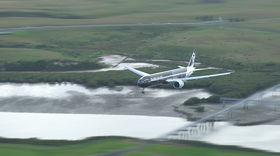
|
Royal New Zealand Air Force's (RNZAF) 75th Anniversary CelebrationsThree-quarters of a century of New Zealand's hugely varied military aviation history was celebrated when the Warbirds Over Wanaka International Airshow hosts the Royal New Zealand Air Force's 75th Anniversary. A large gathering of key personnel who have served over the decades met in Wanaka, along with a unique collection of the aircraft that served them in a wide range of operations. In low powered early monoplanes, much-admired WWII-era fighters and later in modern jets and transporters, Kiwi pilots and their ground crews have historically played a myriad of defence and humanitarian roles internationally. Operations in a range of locations such as Vietnam, the Middle East, Antarctica, Africa, the South Pacific, Eastern Europe and beyond would be recalled at the Easter holiday event, as many of the aircraft involved in those operations flew overhead. |

|
HerculesNo. 40 Squadron, RNZAF, operates five C130H Hercules provides strategic air transport and tactical air transport capability. The Hercules is used to support the NZ Antarctic Programme, and in disaster relief and humanitarian operations, aero-medical evacuation and civil defence support in New Zealand and the South Pacific. |
|
SeaspriteNo. 6 Squadron, RNZAF, operate five Kaman SH-2G (NZ) Seasprite helicopters. This multi-purpose helicopter conducts a variety of tasks, including surface and sub-surface warfare missions, surveillance operations, search and rescue, aero-medical evacuation and VIP flights. The Seasprite operates from the ANZAC class Frigates HMNZS TE MANA and TE KAHA, and the multi-role vessel HMNZS CANTERBURY. In the future they will operate from two Off-Shore Patrol Vessels. |
|
IroquoisThe Air Force's popular Iroquois helicopters are operated by No. 3 Squadron, RNZAF. These versatile helicopters are used by the Air Force for a range of tasks including operational support and training for the NZ Army, specifically in tactical air transport, special operations and aero-medical evacuation. No. 3 Squadron also maintains a 24/7 standby for search and rescue and provide support to NZ Police and other government agencies. On occasion the Squadron also undertakes VIP transport. |
|
Agusta 109Eight aircraft were purchased by the RNZAF in 2010 to replace the Sioux. The service name for these aircraft is Mako. The Agusta was developed for light attack, close support or for naval operations. |
|
Red CheckersThe Air Force's aerobatic team has been wowing crowds since the end of WWII, gaining the official title 'Red Checkers'in 1967. The wholly volunteer display team is made up of pilots drawn from the Central Flying School supplemented by Qualified Flying Instructors from the Pilot Training Squadron as required. Practices for each summer season are carried out in their spare time, normally before or after the normal workday routine. The Red Checkers perform their routines in CT-4E Airtrainers. |
|
Kiwi BlueOne of the most visual aspects of the Air Force's Parachute Training and Support Unit (PRSU) is the parachute display team "Kiwi Blue". The team, made up from members of PRSU, regularly perform at air shows and open days here in New Zealand and overseas. The use of Áir Force' emblazoned parachutes and coloured smoke by the descending team provides spectacular viewing. |
|
P-3K OrionRNZAF Lockheed aircraft with four Allison engines and a cruising speed of 340 kts. The RNZAF currently operates six P-3K Orions. It took delivery of five P-3B Orions in 1966 (NZ4201 - NZ4205). In 1985 an ex-RAAF P-3B was purchased (NZ4206)All six Orions were upgraded (avionics and radio systems) under project RIGEL in the early 1980s. Following the upgrade the designation P-3K has been applied to these aircraft. |
|
Hawker Beechcraft T-6C Texan IIT-6C Texan II, complete with ejector seats, advanced avionics and aerobatic capabilities, are built by the Hawker Beechcraft Defense Company, in Kansas, USA. The aircraft are used to train pilots, navigators and weapons system officers from more than 20 different countries around the world. It is the primary flight trainer for the U.S. Air Force and U.S. Navy, as well as the primary trainer for NATO Flying Training Canada, the Hellenic Air Force, the Israeli Air Force, the Iraqi Air Force, the Royal Moroccan Air Force and the Mexican Air Force. The Texan has a top speed of 316 knots, G limits of +7g to -3.5, hard-point wings, an integrated glass cockpit and an advanced avionics suite. It is equally adept at teaching the most advanced aerobatic manoeuvres and simulated combat training tasks that could previously only be accomplished in far more expensive aircraft. In addition aircraft flown at WOW by the RNZAF: |
 |
Grumman AvengerThe rugged Grumman Avenger, which has folding wings, was designed as a carrier-borne torpedo bomber. It was one of the largest single engine fighters of its time, built by General Motors initially for the United States Navy and Marine Corps. The aircraft was an important RNZAF fighter used in the Pacific campaigns of WWII, built as a bomber. Often used as a torpedo bomber off US aircraft carriers. This example, built in 1945, will be flown today by Squadron Leader Jim Rankin. |
|
Corsair FG-1DThe RNZAF operated 400 of the Goodyear FG-1D Corsair aircraft during WW11 and NZ5648 is the last remaining in operation. It is powered by a 2000hp Pratt and Whitney radial engine and can cruise at 44,000ft. It can travel at 450mph with a range of 1500km without refueling. Nicknamed "Whistling Death" by the Japanese because of its exceptionally quiet approach,due to the airflow through the oil coolers in the wing roots, the Corsair soon helped gain air superiority. |
|
Curtiss P-40 KittyhawkFirst flown in 1938, the Curtiss Kittyhawk operated in almost every theatre of war during WWII. The RNZAF operated 297 of these fighters in the Pacific during WWII and were responsible for downing 99 Japanese aircraft. Replaced by the Vought Corsair in 1944, the P-40 returned to New Zealand as an advanced fighter trainer. |
|
North American P-51D MustangThe British inspired, American built Mustang was one of the most potent and versatile fighters of WWII. Operated as a long range escort and in the close air support role, it became the first fighter capable of accompanying American bombers all the way to Berlin and back. When first flown in 1940, it was powered by an Allison engine but later models were powered by a Packard Merlin, which provided it with considerable extra power at higher altitudes. It became known as the "Cadillac of the Skies". |
|
de Havilland VampireThe Vampire was the first UK's single-engined jet fighter, the prototype first flying in September 1943. Entering service with the RAF in 1946, the type also became the first operational jet aircraft with the RNZAF. The first examples arrived in 1951 and equiped No's 14 and 15 Squadrons at Ohakea. The Vampire remained in service until 1972 when replaced by the BAC Strikemaster. It was flown by 21 countries including Australia, where 109 were built under licence. |
|
DC-3The DC-3 served in World War II , Korea and Vietnam and was a favourite among pilots. For more than 70 years, the aircraft known by a variety of nicknames - the Doug, the Dizzy, Old Methuselah, the Gooney Bird (US Air Force), the Grand Old Lady - but which to most of us simply the Dakota has been the workhorse of the skies. With its distinctive nose-up profile when on the ground and extraordinary capabilities in the air, it transformed passenger travel and served in just about every military conflict from World War II onwards. |
|
StrikemasterProduced by the British Aircraft Company Ltd in England, the Strikemaster was exported to Saudi Arabia, South Yemen, Kuwait, Oman, Singapore, Kenya, Ecuador and New Zealand. Its main use was in training aircraft, although it was used in a combat role by some. The Strikemaster Mk 88 was purchased by the New Zealand Government to replace the aging Vampires. Sixteen were acquired for the RNZAF, the first batch being delivered in 1972, the remainder in 1975. All the aircraft were operated by No. 14 Squadron based at Ohakea and were used for jet conversion and advanced pilot training. The Strikemaster was affectionately known as the 'blunty' because of its nose shape. Three aircraft were lost in accidents, and the fleet was withdrawn from service in 1991 and replaced by the Aermacchi MB339CB. Most of the ex-RNZAF Strikemasters form part of the Australian warbirds community. One is flying in the United States and two in New Zealand. |
|
North American HarvardIn RNZAF service as a pilot trainer for more than three decades the Harvard was first flown in 1937. Known as the Harvard in the British Commonwealth, T-6 Texan in the USAF and SNJ by the US Navy, over 21,000 examples were built. The Harvard was used as the primary trainer for most Commonwealth aircrew during WWII, after they had flown solo in the Tiger Moth. Fully aerobatic, it was a delight to fly, but not too easy for the novice who one day would move onto single seat fighter aircraft. |
|
De Havilland DHC-2 BeaverPowered by a sturdy nine cylinder Pratt & Whitney radial engine, the Beaver is a much-loved hard working machine. Many were built for the United States military and are now renowned here and overseas as reliable bush planes and agricultural work horses. First flown in 1947, Beavers continued to be produced commercially until the late 1960s. Many of the 1600-odd Beavers built are still flying today. Testament to its practical nature and suitability for cold climates is the fact that the Beaver’s oil filler spout and dipstick are located in the cockpit. This allows the (unrecommended) activity of topping up the oil with one hand and flying the plane with the other. The Beaver can carry six to eight people or 950kg of cargo and ticks along happily at around 230km/h. |
|
Supermarine SpitfiresWW11 piston-engine aircraft were lining up two by two for the airshow with two Supermarine Spitfires now on the programme as well as two P-51 Mustangs and two P-40 Kittyhawks. Returning to Wanaka for its second appearance would be the immaculate Supermarine Spitfire owned by the Deere family of Marton. The fighter was restored by the family and decorated in honour of family member Air Commodore Alan Deere who served with the RAF for forty years. The second Spitfire, also resident in New Zealand, is owned by Auckland businessman and aerobatic champion Doug Brooker. The aircraft saw much combat action in WW11 and was converted into a two-seater after the war for training purposes. It was imported to New Zealand in 2008, missing the airshow that year. It had since been repainted in the colour scheme and markings of the Mark IX Spitfire flown in the North Africa campaign by Squadron Leader Colin Gray, New Zealand’s highest scoring Ace. |
|
Yakovlev Yak 3-MNicknamed "Dogfighter Supreme", the Yak 3 was the ultimate refinement in Soviet wartime fighter development. The smallest and lightest combat fighter of WW11, upon entering combat with the Luftwaffe. It was found to be so much superior to the Focke-Wulf 190 and the ME-109 that a signal was sent to all squadrons saying, "avoid all combat below 10,000 feet with any Yak fighter lacking an oil cooler under the nose".
|
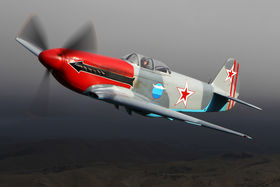
|
WWI Aircraft: |
|
Fokker D-8The ‘Flying Razor’ - an extremely rare aircraft which was considered the German’s deadliest fighter in the first World War. The building of the Fokker D-8 was completed late last year by the internationally acclaimed North Island Vintage Aviator specialist restoration company. The aircraft is a replica with a reproduction rotary engine. There is only one original D-8 remaining in the world, held at the Caproni Museum in Italy. The nimble German D-8 fighter was a parasol-winged monoplane which entered WWI late but was quickly acknowledged as a formidable foe by Allied pilots. It carried two machine guns and was extremely manoeuverable in comparison to its predecessors. |
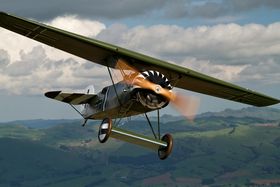
|
Sopwith CamelFirst produced in 1917 there are no original airworthy examples of the Sopwith Camel currently flying. This biplane was one of the most significant aircraft to emerge from the First World War by claiming more victories than any other Allied aircraft during the time. Nearly 1300 enemy aircraft were shot down by Sopwith Camels, but Camel pilots encountered 385 non-combat deaths due to inexperienced piloting. Pilots often found that the Camel flipped at a very low speed so taking off and landing were done with extreme caution. It is a highly manoeuverable and agile aircraft that is 5.72m long, 2.59m high, and can reach a top speed of 199km/h. |
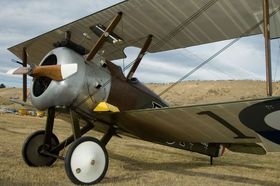
|
British Bristol FighterThis was a very successful two-seater aircraft which served in New Zealand during the early days of the RNZAF, known then as the New Zealand Permanent Air Force. Bristol Fighters were used for pilot training, aerial surveying, and gathering meteorological data in this country and flew in combat with the RAF in Europe, some piloted by New Zealanders such as the highly decorated fighter ace, Sir Keith Park.
|
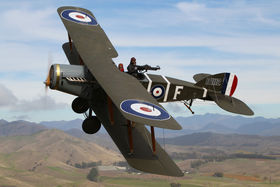
|
Havilland DH82A Tiger MothThe most famous of all de Havilland aircraft in this country is the Tiger Moth. Flown in its hundreds in the Air Force, topdressing, aero club, gliding club and private use it was once the primary trainer for NZ fighter pilots. It is being seen in increasing numbers as more long term rebuilds take to the air |
|
Hawker HunterHawker Hunter jet fighters first flew in 1951 and were used by the Royal Air Force for almost 50 years. The Hawker was often compared to the Skyhawk, being similar in size, weight, performance and specification to the A4 Skyhawk but faster and capable of flying higher. Made by the same company that made the Hurricane and the Harrier, the Hawker took out the world speed record at 727 mph in 1953 and was the RAF’s first fighter capable of breaking the sound barrier. As a ground attack fighter it had enormous firepower and carried canons, bombs, rockets, sidewinder air to air missiles and the Maverick guided missile. This aircraft, built in 1957, served with the RAF in Germany. In 1970 it was completely refurbished and delivered to the Singapore Air Force where it served until 1992. Imported to New Zealand in 1995, it was refurbished again at Ardmore. |
|
MX2The MX2 is a purpose-built Unlimited Aerobatic aircraft developed from the highly-successful Giles G202/CAP222 aircraft.Built by MXR Technologies Inc. in Florida, it has an all carbon fibre monocoque airframe. During displays it burns two litres of avgas per minute and three litres per minute of smoke oil. The loading ranges from +8.5g to -6.5g during a display, in what is a state-of-the-art machine in the world of aerobatic aircraft. |
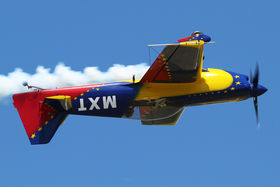
|
Master of the Model... Frazer BriggsWatching one of Frazer Brigg’s neat little aircraft gracefully loop and dive above the runway at Wanaka is a mesmerising experience. His Raven has a wingspan of just over 3 metres and is powered by a small but powerful 200cc, four cylinder motor. Frazer, who has a software development company near Hamilton has been a regular at Wanaka for the past six airshows. |

|